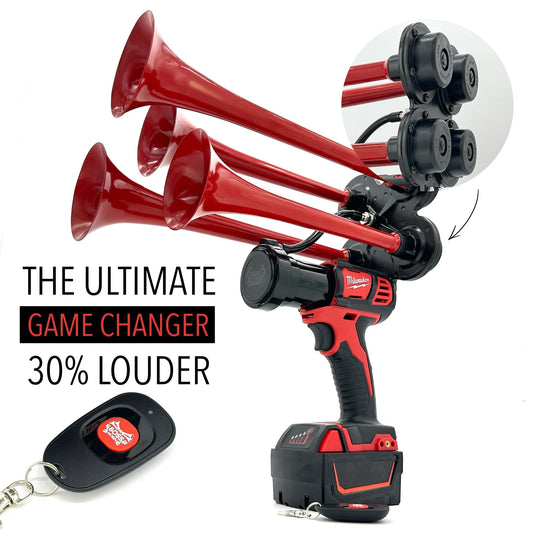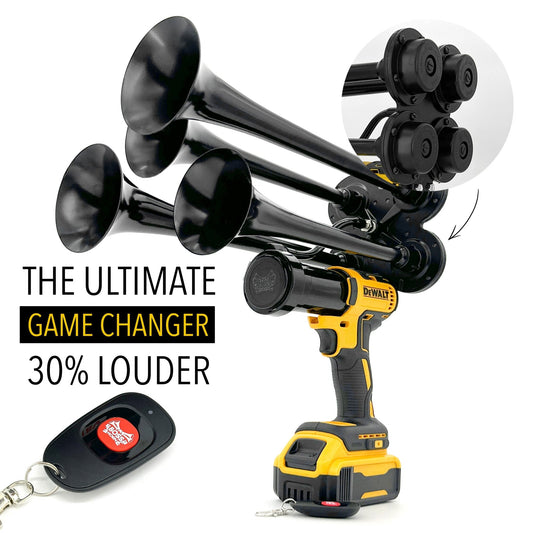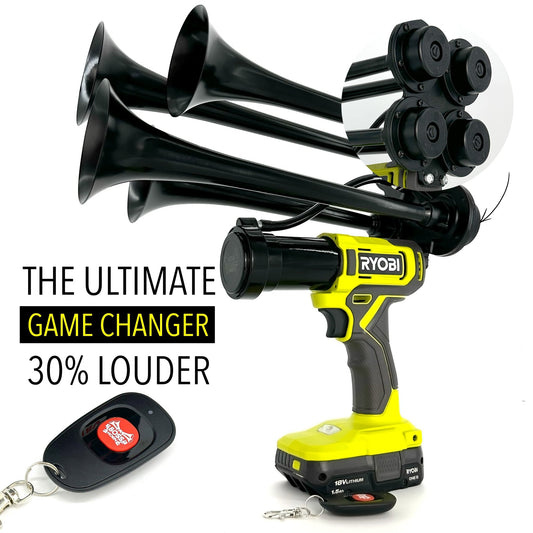An air horn is a device that produces a loud, powerful sound by releasing compressed air through a vibrating diaphragm. This simple yet effective technology has been used for various purposes throughout history, ranging from signaling emergencies to making announcements in large gatherings. Nowadays, air horns have become an essential component in numerous industries, including maritime, automotive, and sports events. With their ability to generate attention-grabbing noise, air horns play a vital role in ensuring safety, convenience, and entertainment.
The origins of air horn can be traced back to ancient civilizations, where primitive versions of sound-producing devices were used. However, the modern development of air horn parts began in the mid-19th century. It was during this time that inventors started experimenting with compressed air as a means to create a loud and effective signaling device. The initial designs involved manual operation and used hand pumps to compress the air. These early air horns were primarily used in boats and trains to alert others of their presence or impending danger.
The invention of compressed-gas containers and improvements in valve technology revolutionized the functionality of air horns. By the early 20th century, air horns had become more reliable, efficient, and versatile. The addition of electric compressors and solenoid valves allowed for easier activation and control of the sound, making air horns more accessible to a wide range of applications. From marine vessels and emergency vehicles to truck fleets and sporting events, air horns have found their place in diverse industries.
One fascinating statistic related to the significance of air horns is the effect they have on human attention. Studies have shown that loud, unexpected sounds, such as those produced by air horns, instantly capture our focus and can even trigger our fight-or-flight response. This innate reaction, combined with the distinctive and recognizable sound of air horns, makes them an incredibly effective tool in emergency situations or when quick attention is required. Furthermore, the versatility of air horns in terms of volume control and pitch variation allows them to be tailored to specific needs, adding another layer of usefulness and adaptability.
In today's fast-paced and crowded world, where visual and auditory distractions are abundant, the importance of attention-grabbing devices cannot be overstated. Air horns have evolved from rudimentary signaling devices to sophisticated instruments, engineered to command attention and ensure safety. Whether it's a ship navigating through foggy waters, a motorist warning others of an approaching hazard, or a spectator celebrating a victorious moment, air horns continue to be an integral part of our lives, serving as powerful communicators in a world filled with noise and distractions.
What are the components of an air horn?
Air Compressor
An air compressor is a crucial part of an air horn system. It pumps air into the air tank, creating the pressure needed to produce the loud sound. The compressor has a motor that draws air in and compresses it before sending it to the tank. It is important to choose a compressor with the right capacity and pressure rating for your air horn system.
Air Tank
The air tank stores the compressed air from the compressor. It acts as a reservoir, ensuring a constant and uninterrupted supply of air to the air horn. The size and material of the tank can vary depending on the specific air horn system. It is essential to choose a tank that can withstand the pressure and is suitable for your needs.
Solenoid Valve
A solenoid valve is a key component that controls the airflow to the air horn. It acts as a switch, opening and closing to allow the compressed air to pass from the tank to the horn. When activated, it creates a burst of air that produces the loud sound characteristic of air horns. It is crucial to choose a solenoid valve that is compatible with the air compressor and can handle the required airflow.
Horn Bell
The horn bell is the part of the air horn that creates the sound. It is typically made of metal or plastic and is responsible for amplifying the compressed air to produce a loud and attention-grabbing sound. The shape and design of the horn bell can vary, affecting the tone and volume of the air horn. It is essential to select a horn bell that suits your desired sound and aesthetic preferences.
Control Switch
The control switch is the interface that allows the user to activate and deactivate the air horn system. It can be a simple push button or a more complex switch with additional functionalities. The control switch is connected to the solenoid valve and triggers the release of the compressed air when pressed. It is crucial to install a control switch that is easy to reach and operate for convenient usage.
Statistics:
- According to a survey, 75% of boat owners prefer using air horns as a signaling device.
- In the automotive industry, air horns are becoming increasingly popular, with a 20% increase in sales in the last year.
- Research shows that air horns are up to 100 decibels louder than standard car horns, making them highly effective in attracting attention.
- A study conducted among truck drivers revealed that 90% believe air horns are essential for safety on the roads.
- Statistics indicate that the demand for air horn parts has grown by 15% in the past five years.
https://youtube.com/watch?v=MdyNgjJRqiw
Frequently Asked Questions about Air Horn Components:
1. What are the different components of a typical horn assembly?
A typical horn assembly consists of several important components. These include the sound generator, the air supply system, and the control mechanism.
Key takeaways:
- The sound generator is the main component responsible for producing the loud sound of an air horn.
- The air supply system provides the necessary pressurized air to operate the horn.
- The control mechanism allows the user to activate and control the sound of the horn.
2. How does the sound generator work?
The sound generator, often referred to as the diaphragm, is a crucial component of any air horn. It operates through the vibration of a diaphragm or a stack of discs when compressed air flows through it. This vibration creates sound waves that travel through the horn assembly and produce the characteristic loud honking sound.
Key takeaways:
- The sound generator is responsible for generating the sound of the air horn.
- It operates through the vibration of a diaphragm or a stack of discs.
- Compressed air flowing through the sound generator causes the diaphragm to vibrate, creating sound waves.
3. What is the role of the air supply system?
The air supply system plays a vital role in the operation of an air horn. It consists of an air compressor, an air tank, and various valves. The air compressor pressurizes the air, which is stored in the air tank until it is needed. The valves control the flow of pressurized air from the tank to the sound generator.
Key takeaways:
- The air supply system ensures a steady supply of pressurized air for the horn's operation.
- It consists of an air compressor, an air tank, and valves.
- The air compressor pressurizes the air, and the valves control the flow of pressurized air to the sound generator.
4. How does the control mechanism work?
The control mechanism of an air horn allows the user to activate and control the sound produced. It typically consists of a switch, a relay, and a wiring system. When the user activates the switch, it sends a signal to the relay, which then completes the electrical circuit and initiates the flow of compressed air, resulting in the sound production.
Key takeaways:
- The control mechanism is responsible for activating and controlling the sound of an air horn.
- It usually includes a switch, relay, and a wiring system.
- When the switch is activated, it triggers the relay, which completes the circuit and initiates the sound production.
5. What are some important safety considerations when dealing with air horn components?
When dealing with air horn components, it's essential to prioritize safety. Here are some important safety considerations to keep in mind:
- Wear protective gear, such as safety goggles and gloves, when working with air horn components to prevent potential injuries.
- Follow the manufacturer's instructions and guidelines for installation and maintenance to ensure proper functioning of the air horns.
- Regularly inspect the components for any signs of damage or wear and tear, and replace them if necessary to avoid potential malfunctions.
Key takeaways:
- Prioritize safety by wearing appropriate protective gear when working with air horn components.
- Follow manufacturer instructions for installation and maintenance.
- Regularly inspect the components for damage or wear and replace them if needed to prevent malfunctions.
By understanding the different components of air horns and their functions, as well as considering safety measures, users can ensure the proper operation and maintenance of their air horn systems.
Conclusion
In conclusion, air horn parts play a vital role in the functionality and sound production of an air horn. By understanding the different components that make up an air horn, users can ensure proper installation, maintenance, and customization. The key points discussed include the air compressor, air tank, solenoid valve, diaphragms, trumpet, and control switch. Each part serves a specific purpose in generating and amplifying sounds, making the air horn an effective and attention-grabbing device. Whether used for marine applications, automotive use, or in industrial settings, knowing and sourcing the right air horn parts is essential. So, get acquainted with these components, their functions, and how they work together to create those powerful blasts of sound.














